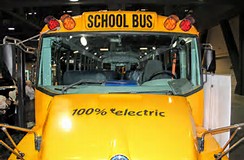As our colleague, Ulrik Andersson, wrote earlier this year, “there has been much attention paid to autonomous cars and trucks recently” but what about school buses?
STN Expo – Reno, Nevada (USA)
At this year’s STN Expo in Reno, Nevada, the two hot topics were electric/hybrid buses and automated/autonomous technology for school buses. These technologies work hand-in-hand to increase safety, lower fuel costs and reduce environmental impact from fuel emissions. Also, many new products were introduced at the expo for use in electric/hybrid buses or that could be used in conjunction with emerging technologies such as automated/autonomous vehicles to the benefit of the school bus industry.

STN Expo Webinar – School Buses in the Autonomous Future
During the expo, School Transportation News (STN), hosted an hour-long webinar presented by Fred Andersky, Director, Customer Solutions & Marketing - Controls at Bendix Commercial Vehicle Systems, discussing the development of automation for school buses. Mr. Andersky defined automated or automation as “reduced human intervention” and autonomous as “driverless, not having a human driver.” He explained that new technology is implemented slowly across industries “taking about five years for trucks to receive the technology, and another 10 to 15 years to trickle down to buses.”
“Driver Assistance, NOT Driver Replacement”
Mr. Andersky said, “The number one non-negotiable factor is that automation and other ‘smart’ functions cannot replace human control in school buses.” But, automation can make driving a school bus safer and easier for the “[…] driver, students, and nearby vehicles.” Also, as Ulrik suggested, “Instead of replacing the driver, automation should improve traffic safety, working conditions and reduce environmental impact.” Automation has reached trucks however for school buses it is still years away.
Vehicle Differences
The main difference between cars, trucks and school buses discussed during the webinar is that cars are a “personal choice” while trucks and buses serve “functional purposes” making the automation challenge vastly different for each. Most people choose a car based on whether they like it or not while choosing a truck or school bus is based on cost, reliability, safety, and return on investment. As Mr. Andersky explained, one major difference among these vehicles is that the laws of physics states that “the larger the vehicle, the more force and distance required to stop it, and then add rain, snow and ice to complicate matters.”
Automatic Tire Chains on Automated/Autonomous Vehicles
Rain, snow and ice affects braking and stopping. The stopping distance requirement for school buses is 280’. Imagine an automated and/or driver assisted vehicle with the technology to detect icy road conditions and deploy tire chains safely and within the guidelines set forth for school buses. An automated bus deploying automatic tire chains without interrupting your pick up route and disengaging when the road clears sounds very “Jetsons-like” but considering the innovations made by companies like Google and Uber, it really is about when, not if.
There is currently an autonomous refuse truck equipped with Onspot Automatic Tire Chains being operated in Sweden – check out the video! School buses are “one of the safest modes of transportation” so it is exciting to see how all this new technology will impact this industry.
Stay Tuned!

